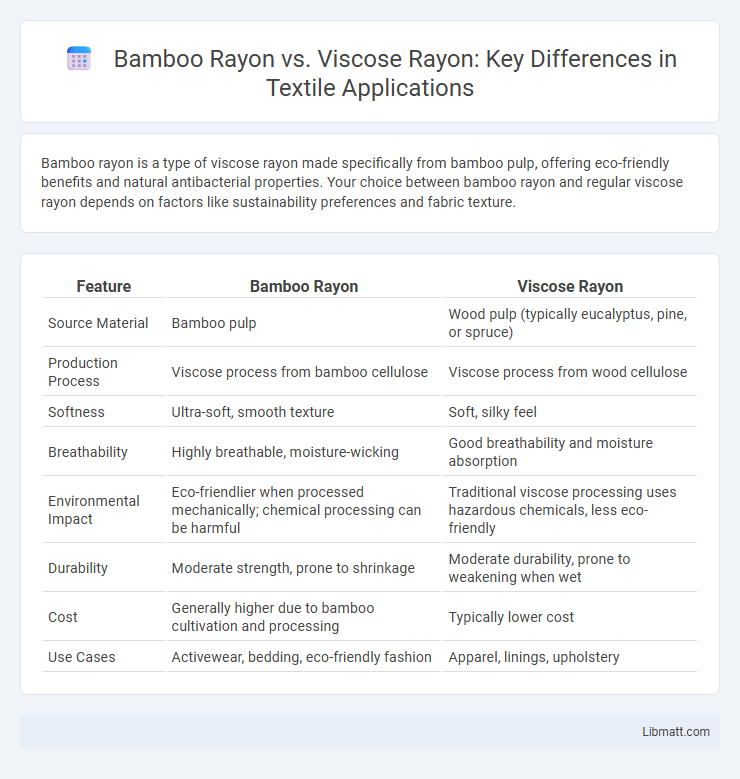Bamboo rayon is a type of viscose rayon made specifically from bamboo pulp, offering eco-friendly benefits and natural antibacterial properties. Your choice between bamboo rayon and regular viscose rayon depends on factors like sustainability preferences and fabric texture.
Table of Comparison
| Feature | Bamboo Rayon | Viscose Rayon |
|---|---|---|
| Source Material | Bamboo pulp | Wood pulp (typically eucalyptus, pine, or spruce) |
| Production Process | Viscose process from bamboo cellulose | Viscose process from wood cellulose |
| Softness | Ultra-soft, smooth texture | Soft, silky feel |
| Breathability | Highly breathable, moisture-wicking | Good breathability and moisture absorption |
| Environmental Impact | Eco-friendlier when processed mechanically; chemical processing can be harmful | Traditional viscose processing uses hazardous chemicals, less eco-friendly |
| Durability | Moderate strength, prone to shrinkage | Moderate durability, prone to weakening when wet |
| Cost | Generally higher due to bamboo cultivation and processing | Typically lower cost |
| Use Cases | Activewear, bedding, eco-friendly fashion | Apparel, linings, upholstery |
Understanding Bamboo Rayon: Definition and Origins
Bamboo Rayon is a type of regenerated cellulose fiber derived specifically from bamboo pulp, known for its softness, breathability, and eco-friendly image due to bamboo's rapid growth and minimal pesticide use. Viscose Rayon, a broader category of rayon made from various cellulose sources like wood or bamboo, undergoes a chemical process that transforms natural fibers into a versatile textile fiber with a silky feel. Understanding Your choice between Bamboo Rayon and Viscose Rayon hinges on recognizing that Bamboo Rayon's unique origin from bamboo distinguishes its sustainability profile and texture from conventional viscose fabrics.
What Is Viscose Rayon? Composition and Manufacturing
Viscose rayon is a semi-synthetic fiber derived primarily from cellulose, often sourced from wood pulp, including bamboo, beech, and eucalyptus trees. Its manufacturing process involves chemically treating cellulose with sodium hydroxide and carbon disulfide to create a viscous solution, which is then spun into fibers through a regeneration process. This production technique gives viscose rayon its characteristic softness, breathability, and versatility used widely in textiles and apparel.
Key Differences Between Bamboo Rayon and Viscose Rayon
Bamboo rayon is derived specifically from bamboo plant fibers, offering a more sustainable and eco-friendly source compared to viscose rayon, which typically comes from various wood pulp sources like beech or pine. The manufacturing process for bamboo rayon often involves fewer chemicals and produces a softer, more breathable fabric known for its natural antibacterial properties. Your choice between bamboo rayon and viscose rayon should consider factors like environmental impact, fabric feel, and durability to best meet your needs.
Environmental Impact: Bamboo Rayon vs Viscose Rayon
Bamboo rayon generally has a lower environmental impact than traditional viscose rayon since it is derived from rapidly renewable bamboo plants that require less water and pesticides. The manufacturing process of bamboo rayon can still involve harmful chemicals like viscose, but eco-friendly closed-loop systems reduce pollution compared to conventional viscose production. Choosing bamboo rayon over viscose rayon supports a more sustainable fabric option by minimizing deforestation and chemical runoff, benefiting your eco-conscious lifestyle.
Production Processes: From Raw Material to Fabric
Bamboo rayon production involves converting bamboo cellulose through a chemical process using sodium hydroxide and carbon disulfide, resulting in a viscose solution that is then spun into fibers. Viscose rayon, derived primarily from wood pulp, undergoes a similar viscose process where cellulose is treated chemically to create a regenerated fiber. Both fabrics rely on the viscose method, but bamboo rayon uses bamboo as its raw material, which may influence sustainability and environmental impact considerations.
Comfort and Performance: Which Fabric Feels Better?
Bamboo rayon offers superior breathability and moisture-wicking properties compared to viscose rayon, resulting in enhanced comfort during wear. Viscose rayon provides a smooth, silky texture but tends to retain more heat and moisture, making it less ideal for prolonged or active use. Bamboo rayon's natural antibacterial qualities further improve performance by reducing odors, making it the preferred choice for comfort-focused apparel.
Durability and Longevity of Bamboo and Viscose Rayon
Bamboo rayon offers superior durability due to its natural fiber strength, making it more resistant to wear and tear compared to standard viscose rayon. Viscose rayon, while soft and breathable, tends to weaken faster with repeated washing and exposure to moisture, reducing its longevity. Choosing bamboo rayon for your garments ensures longer-lasting fabric performance and sustained comfort over time.
Cost Comparison: Pricing and Affordability
Bamboo rayon generally costs more than viscose rayon due to its eco-friendly production process and sustainable sourcing. Viscose rayon is more affordable, making it a popular choice for budget-conscious consumers seeking soft, breathable fabrics. Your decision between bamboo and viscose rayon ultimately depends on balancing cost with environmental impact and fabric quality.
Common Uses and Product Applications
Bamboo rayon and viscose rayon are widely used in textiles for clothing, home furnishings, and activewear due to their soft texture and breathability. Bamboo rayon is favored for eco-friendly products like baby clothes, bedding, and towels because of its natural antibacterial properties and moisture-wicking ability. Your choice between bamboo rayon and viscose rayon depends on product requirements, with viscose rayon commonly applied in fashion apparel and upholstery for its smooth drape and affordability.
Making the Right Choice: Bamboo Rayon or Viscose Rayon?
Choosing between bamboo rayon and viscose rayon depends on factors such as sustainability, softness, and breathability. Bamboo rayon is derived from bamboo pulp, offering eco-friendly benefits and natural antibacterial properties, while viscose rayon, made from wood pulp, tends to have a softer feel but may involve more intensive chemical processing. Considering environmental impact, fabric texture, and intended use can help determine the better option for apparel or textile applications.
Bamboo Rayon vs Viscose Rayon Infographic

 libmatt.com
libmatt.com